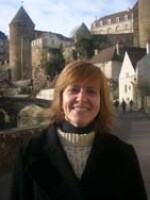The Louvre had a record 9 million visitors last year, and about 10 percent of them were American. Yet the iconic Paris art museum only has four American paintings in its huge permanent collection.
But the Louvre's curators want to change that and heighten the public's knowledge and awareness of early American art with a new exhibit.
Nationwide, French museums own some 2,000 American paintings, but those Whistlers, Homers and Cassatts are exhibited in more modern museums such as the Musee d'Orsay.
The Louvre's collections don't go beyond the year 1848. So the museum is trying to put the spotlight on early American art with an exhibit that runs through April 16, called "New Frontier: American Art Enters the Louvre."

The collection explores American landscape painting, which curator Guillaume Faroult says all began with Thomas Cole in the early 19th century.
"Thomas Cole was the first to say, 'Well, we have American scenery, which is completely different, and we have to be aware of it and be proud of it. And we have to paint it.' So that's what he did," says Faroult.
Cole's paintings show Indians, the blood-red leaves of North American autumns and dramatic scenery. Faroult says Europeans were stunned when his landscapes were first exhibited in London and Rome in the 19th century.
"The colors were quite different, and also the scale was gigantic. He was showing mountains, cliffs, lakes that were looking like seas, they looked gigantic. And the European critics said, 'Well, it's not real, it's unbelievable,' " Faroult says.
More American Exhibits To Follow
The colors were quite different, and also the scale was gigantic. [Thomas Cole] was showing mountains, cliffs, lakes that were looking like seas, they looked gigantic. And the European critics said, 'Well, it's not real, it's unbelievable.'
This small, five-painting exhibit will travel to Atlanta and Arkansas later this year. It's sponsored by the Louvre and three U.S. art institutions. Three other American exhibits will follow in the next four years, focusing on themes such as scenes from daily life and portraits at the time of the American Revolution.
In addition, there will be talks and conferences to help boost the French public's appreciation for early American art. Faroult says public support is important to the Louvre's efforts to acquire paintings in a highly competitive and expensive international art market.
Visitors trickle in to the American landscape room from Goya's and El Greco's next door in the Spanish hall. Middle-school teacher Danielle Le Bourse says she came to the Louvre especially to see the American paintings, although she says she's a little disappointed by the size of the exhibit.
"I know American literature better. We don't really know American art, aside from Andy Warhol," she says. "But these paintings are nice, and the colors are flamboyant."
Faroult says he has a surprise. He can't give any details yet because it's not a done deal, but he says the Louvre may be about to acquire another American painting — which would make it the fifth in its permanent collection of 4,000 paintings.
Copyright 2021 NPR. To see more, visit https://www.npr.org.



